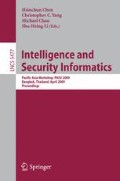Abstract
The issue of fraudulent financial reporting has drawn much public as well as academic attention. However, most relevant researches focus on predicting financial distress or bankruptcy. Little emphasis has been placed on exploring the financial reporting fraud itself. This study addresses the challenge of obtaining an enhanced understanding of the financial reporting fraud through the approach with the following four phases: (1) to identify a set of financial and corporate governance indicators that are significantly correlated with fraudulent financial reporting; (2) to use the Growing Hierarchical Self-Organizing Map (GHSOM) to cluster data from listed companies into fraud and non-fraud subsets; (3) to extract knowledge from the fraudulent financial reporting through observing the hierarchical relationship displayed in the trained GHSOM; and (4) to provide justification to the extracted knowledge.
Access this chapter
Tax calculation will be finalised at checkout
Purchases are for personal use only
Preview
Unable to display preview. Download preview PDF.
References
Association of Certified Fraud Examiners. Report to the nation on occupational fraud & abuse [Electronic Version], http://www.acfe.com/documents/2006-rttn.pdf
Altman, E.I.: Financial ratios, discriminant analysis and the prediction of corporate bankruptcy. The Journal of Finance 23(4), 589–609 (1968)
Beasley, M.S., Carcello, J.V., Hermanson, D.R.: Fraudulent financial reporting: 1987-1997 an analysis of U.S. public companies (1999)
Bell, T.B., Carcello, J.V.: A Decision Aid for Assessing the Likelihood of Fraudulent Financial Reporting. Auditing 19(1), 169–184 (2000)
Dittenbach, M., Merkl, D., Rauber, A.: The Growing Hierarchical Self-Organizing Map. In: The Proceedings of the IEEE-INNS-ENNS International Joint Conference on Neural Networks- IJCNN 2000 (2000)
Dittenbach, M., Rauber, A., Merkl, D.: Uncovering hierarchical structure in data using the growing hierarchical self-organizing map. Neurocomputing 48(1-4), 199–216 (2002)
Fanning, K.M., Cogger, K.O.: Neural network detection of management fraud using published financial data. International Journal of Intelligent Systems in Accounting, Finance & Management 7(1), 21–41 (1998)
Hoogs, B., Kiehl, T., Lacomb, C., Senturk, D.: A genetic algorithm approach to detecting temporal patterns indicative of financial statement fraud. Intelligent Systems in Accounting Finance and Management 15(1/2), 41–56 (2007)
Kirkos, E., Spathis, C., Manolopoulos, Y.: Data Mining techniques for the detection of fraudulent financial statements. Expert Systems with Applications 32(4), 995–1003 (2007)
Loebbecke, J.K., Eining, M.M., Willingham, J.J.: Auditors’ experience with material irregularities: frequency, nature, and detectability. Auditing 9(1), 1–28 (1989)
Persons, O.S.: Using financial statement data to identify factors associated with fraudulent financial reporting. Journal of Applied Business Research 11(3), 38–46 (1995)
Rauber, A., Merkl, D., Dittenbach, M.: The Growing Hierarchical Self-Organizing Map: Exploratory Analysis of High-Dimensional Data. IEEE Transactions on Neural Networks 13(6), 1331–1341 (2002)
Shih, J.-Y., Chang, Y.-J., Chen, W.-H.: Using GHSOM to construct legal maps for Taiwan’s securities and futures markets. Expert Systems With Applications 34(2), 850–858 (2008)
Tipgos, M.A.: Why management fraud is unstoppable. CPA Journal 72(12), 34–41 (2002)
Virdhagriswaran, S., Dakin, G.: Camouflaged fraud detection in domains with complex relationships. In: The Proceedings of the 12th ACM SIGKDD international conference on Knowledge discovery and data mining (2006)
Author information
Authors and Affiliations
Editor information
Editors and Affiliations
Rights and permissions
Copyright information
© 2009 Springer-Verlag Berlin Heidelberg
About this paper
Cite this paper
Tsaih, RH., Lin, WY., Huang, SY. (2009). Exploring Fraudulent Financial Reporting with GHSOM. In: Chen, H., Yang, C.C., Chau, M., Li, SH. (eds) Intelligence and Security Informatics. PAISI 2009. Lecture Notes in Computer Science, vol 5477. Springer, Berlin, Heidelberg. https://doi.org/10.1007/978-3-642-01393-5_5
Download citation
DOI: https://doi.org/10.1007/978-3-642-01393-5_5
Publisher Name: Springer, Berlin, Heidelberg
Print ISBN: 978-3-642-01392-8
Online ISBN: 978-3-642-01393-5
eBook Packages: Computer ScienceComputer Science (R0)

